-
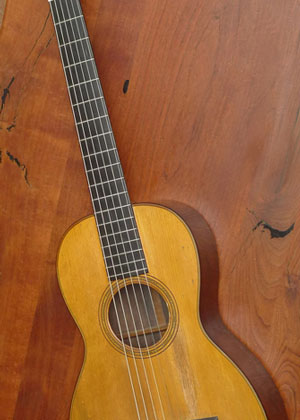 Considered by many to be most charming, intimate, 19th century Martin parlor guitar, the Martin 3-17 features Brazilian Rosewood back and sides, Adirondack spruce top, and Jerome tuners. This particular instrument, with an unbelievably beautiful, lyrical voice, was made in the early 1850’s, as we can tell by several clues. It’s a lot like Mark Twain’s famous Martin 2 ½-17 (see photo). Of course, it has to have the “CF Martin New York” not “CF Martin & Co” stamps– as this one does, to make it a pre-1867 Martin. Also, according to Martin scholars, Jerome tuners seem to have faded out by the late 1850s, to be replaced with similar tuners with a shorter plate and no name stamp. It is unusual on this guitar that the Jerome tuners are German silver, as most of the style 17 guitars have brass tuners. With the “tulip-shaped” tuner buttons, experts date the guitar to the early 1850s. The top is fan braced. Measurements are: body length 17.25″, lower bout width 11.125″, upper bout width 8.25″, overall length 35.75″, scale length just shy of 24 inches. 12 fret cedar neck with ice cream cone heel. Note that the black paint on the back of the neck and back of headstock was removed in some previous century– that does give a nice look at the cedar that would normally be obscured by the black “ebonized” paint. The body of the guitar had some overspray, but it turned out go be one of those fortunate occasions where it was light and really just sitting on top of the original finish, so we are able to easily remove it and reveal the original finish. A couple of small hairline cracks in back, repaired. Top and sides are crack-free. Reproduction ebony bridge. Original bar frets. Original Jerome Silver tuners, with original buttons. Original bracing and bridge plate. “C.F. MARTIN / NEW YORK” hot stamped on back, inside back brace and heel block (but the back stamp is faded). A previous owner of this guitar had a custom hard shell case made– it’s a professional quality, premium case that protects the guitar quite well– it’s heavy and sturdier than most new expensive hard shell cases. Historical interest aside (pre-civil war Martin guitars are rare), this guitar plays wonderfully. It projects the sweetest, but robust, glassy trebles, and clear mids and bass notes. It’s just a joy to play, and it just floats in your hands. (Note: 19th century Martins can be fitted with: gut strings, classical guitar strings, or extra light steel strings– depending on the guitar. It’s really a case-by-case basis, determining whether a particular 19th century Martin can “hold” or “withstand” very light gauge steel strings for example. One size does not fit all. And different 19th century Martins sound better with different strings. In this case, with this particular guitar, extra light steel strings are perfect. It can hold them fine– due to the structure of the top, the bridge plate, and bridge. And it plays and sounds perfect with those strings. This guitar is real find in that regard– not for the collector’s wall but for the player who wants to experience what the original CF Martin felt when he held this instrument in his hands in Nazareth, Pennsylvania, when Abraham Lincoln had not the slightest inkling he’d be in the White House and was just forging a reputation as an outstanding lawyer and earning the nickname of ‘Honest Abe’, and the New York Times was just commencing operations, and the first oil well had just been drilled in the United States by “Colonel” Edwin Drake in Titusville, Pennsylvania– that despite being in C.F. Martin’s state was darn near the old west at the time. In a custom made, professional quality hard shell case.
Considered by many to be most charming, intimate, 19th century Martin parlor guitar, the Martin 3-17 features Brazilian Rosewood back and sides, Adirondack spruce top, and Jerome tuners. This particular instrument, with an unbelievably beautiful, lyrical voice, was made in the early 1850’s, as we can tell by several clues. It’s a lot like Mark Twain’s famous Martin 2 ½-17 (see photo). Of course, it has to have the “CF Martin New York” not “CF Martin & Co” stamps– as this one does, to make it a pre-1867 Martin. Also, according to Martin scholars, Jerome tuners seem to have faded out by the late 1850s, to be replaced with similar tuners with a shorter plate and no name stamp. It is unusual on this guitar that the Jerome tuners are German silver, as most of the style 17 guitars have brass tuners. With the “tulip-shaped” tuner buttons, experts date the guitar to the early 1850s. The top is fan braced. Measurements are: body length 17.25″, lower bout width 11.125″, upper bout width 8.25″, overall length 35.75″, scale length just shy of 24 inches. 12 fret cedar neck with ice cream cone heel. Note that the black paint on the back of the neck and back of headstock was removed in some previous century– that does give a nice look at the cedar that would normally be obscured by the black “ebonized” paint. The body of the guitar had some overspray, but it turned out go be one of those fortunate occasions where it was light and really just sitting on top of the original finish, so we are able to easily remove it and reveal the original finish. A couple of small hairline cracks in back, repaired. Top and sides are crack-free. Reproduction ebony bridge. Original bar frets. Original Jerome Silver tuners, with original buttons. Original bracing and bridge plate. “C.F. MARTIN / NEW YORK” hot stamped on back, inside back brace and heel block (but the back stamp is faded). A previous owner of this guitar had a custom hard shell case made– it’s a professional quality, premium case that protects the guitar quite well– it’s heavy and sturdier than most new expensive hard shell cases. Historical interest aside (pre-civil war Martin guitars are rare), this guitar plays wonderfully. It projects the sweetest, but robust, glassy trebles, and clear mids and bass notes. It’s just a joy to play, and it just floats in your hands. (Note: 19th century Martins can be fitted with: gut strings, classical guitar strings, or extra light steel strings– depending on the guitar. It’s really a case-by-case basis, determining whether a particular 19th century Martin can “hold” or “withstand” very light gauge steel strings for example. One size does not fit all. And different 19th century Martins sound better with different strings. In this case, with this particular guitar, extra light steel strings are perfect. It can hold them fine– due to the structure of the top, the bridge plate, and bridge. And it plays and sounds perfect with those strings. This guitar is real find in that regard– not for the collector’s wall but for the player who wants to experience what the original CF Martin felt when he held this instrument in his hands in Nazareth, Pennsylvania, when Abraham Lincoln had not the slightest inkling he’d be in the White House and was just forging a reputation as an outstanding lawyer and earning the nickname of ‘Honest Abe’, and the New York Times was just commencing operations, and the first oil well had just been drilled in the United States by “Colonel” Edwin Drake in Titusville, Pennsylvania– that despite being in C.F. Martin’s state was darn near the old west at the time. In a custom made, professional quality hard shell case. -
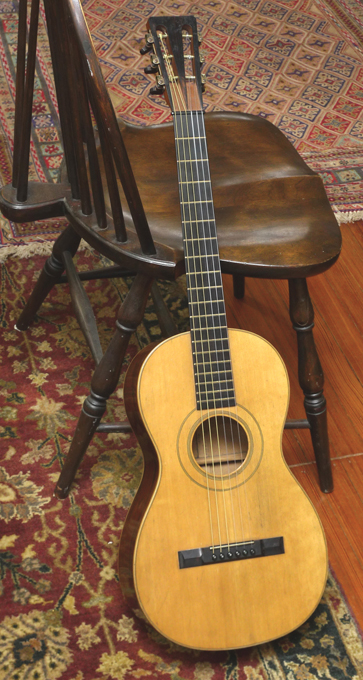 Circa 1860 parlor guitar style 1 built by well known luthier, James Ashborn of Wolcottville, CT, for William hall & son music store. Brazilian rosewood back and sides; Adirondack top; maple binding. This guitar is crack free save for a couple of minor finish cracks on back, and is 100% original, including all original finish, and down to original nut, original bridge (and saddle) that has never been off the guitar, and original bridge pins. From a just-published article in Vintage Guitar magazine: “Ashborn's design for the guitar was quite innovative for the early 19th century. Instead of making guitars fashioned after the typical parlor-style guitars, he made them in the Spanish style, by taking interior bracing cues from the Spanish while retaining the body of the English guitars. This included a fan brace pattern rather than the more common ladder pattern Ashborn guitars have a very complex dovetail V joint for attaching the head to the neck. The headstock was cut in roughly five steps, using some kind of tracing router, as suggested by the chatter marks on the inside ears of the pegbox. In addition to the complex head design, Ashborn made his own tuning machines in-house. They're made of brass, very much like contemporary machines, with worm gears, cog gears, and rollers. … Ashborn's shop was extremely advanced for its time, having a great deal of know-how and technology. Ashborn understood the need to have the technology as well as the skill, but more importantly he discovered a new way of making high-quality instruments that were affordable. He was able to create a factory environment where workers did what they were good at and, with practice, became very fast and consistent. With a new level of consistency in mass production, he created the path followed by other companies such as Martin, Gibson, and Taylor. Using designs ahead of his time, he was able to bring the sound and change to people who otherwise never would have been able to acquire an instrument of this quality.” This beautiful all-original and crack-free Ashborn guitar is one of the best-preserved examples in existence.
Circa 1860 parlor guitar style 1 built by well known luthier, James Ashborn of Wolcottville, CT, for William hall & son music store. Brazilian rosewood back and sides; Adirondack top; maple binding. This guitar is crack free save for a couple of minor finish cracks on back, and is 100% original, including all original finish, and down to original nut, original bridge (and saddle) that has never been off the guitar, and original bridge pins. From a just-published article in Vintage Guitar magazine: “Ashborn's design for the guitar was quite innovative for the early 19th century. Instead of making guitars fashioned after the typical parlor-style guitars, he made them in the Spanish style, by taking interior bracing cues from the Spanish while retaining the body of the English guitars. This included a fan brace pattern rather than the more common ladder pattern Ashborn guitars have a very complex dovetail V joint for attaching the head to the neck. The headstock was cut in roughly five steps, using some kind of tracing router, as suggested by the chatter marks on the inside ears of the pegbox. In addition to the complex head design, Ashborn made his own tuning machines in-house. They're made of brass, very much like contemporary machines, with worm gears, cog gears, and rollers. … Ashborn's shop was extremely advanced for its time, having a great deal of know-how and technology. Ashborn understood the need to have the technology as well as the skill, but more importantly he discovered a new way of making high-quality instruments that were affordable. He was able to create a factory environment where workers did what they were good at and, with practice, became very fast and consistent. With a new level of consistency in mass production, he created the path followed by other companies such as Martin, Gibson, and Taylor. Using designs ahead of his time, he was able to bring the sound and change to people who otherwise never would have been able to acquire an instrument of this quality.” This beautiful all-original and crack-free Ashborn guitar is one of the best-preserved examples in existence. -
Out of stock
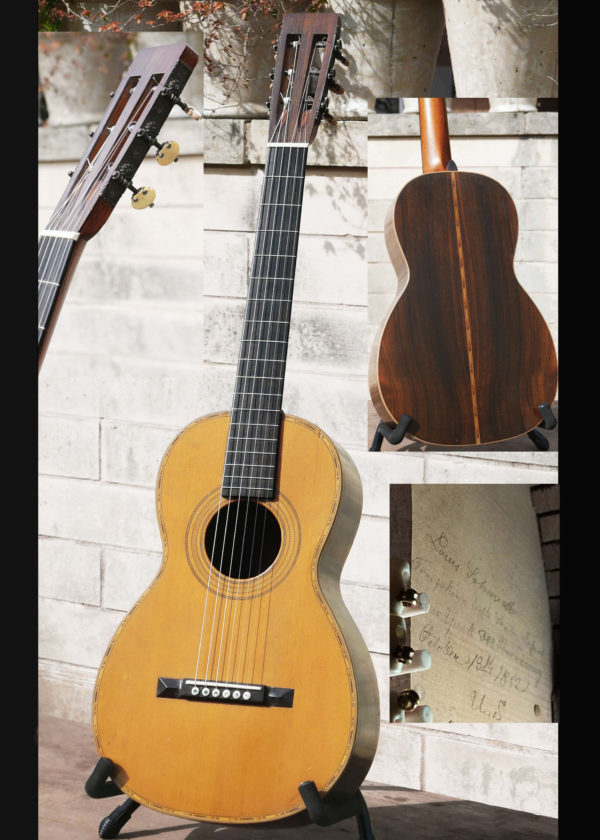 It’s beyond rare to find a guitar from the early Martin – Coupa - Schmidt – Maul – Schatz era in this state of preservation. And one this large. This rare model Schmidt & Maul guitar – by the original C.F. Martin's most famous colleagues and contemporaries– is signed and dated, October 18th, 1852, and is in its original coffin case. And best of all– it plays wonderfully, with low action. A unique piece of American guitar history– not for hanging on the wall but to play. The instrument is signed on the underside of the top: Louis Schmidt Tompkinsville Staten Island New York 388 Broadway October 18th 1852 U.S. This higher end, Spanish neck/heel (not ice-cream cone) Schmidt & Maul is bigger than all the Schmidt & Maul, Schmidt, or George Maul guitars that have come up for sale in the past decades (and not many of any kind have come up for sale). It’s a bit larger than a size 2 Martin, with a width at lower bout of 12 3/16 inches.(Every other Schmidt & Maul that has come to market has been a smaller guitar.) The guitar is braced inside (all original) with an early X-bracing variation similar to the 1953 Schmidt & Maul featured on p. 213 of the book “Inventing the American Guitar– The Pre-Civil War Innovations of C.F. Martin and His Contemporaries” edited by Robert Shaw and Peter Szego. (Hal Leonard Books, 2013). Like the 1853 guitar illustrated in that book, this guitar has bracing on top and back that is very close to the guitar that CF Martin and Schatz made for Madame de Goni. With all original finish, original ebony bridge, and original Jerome tuners– it’s in remarkable condition. To get the best of both worlds– historically authenticity and playability– the guitar has just had a recent neck set, original bridge reglue, and other minor work including new saddle, by one of the country’s top luthiers and authorities for early Martin and early American guitars– Steve Kovacik. All work was done by Steve to historically correct preservation standards after extensive examination and consultation. (Note, in the photo: the picture of the signature inside the guitar: the two cleats are not later repairs– rather they are two center seam-stabilizing cleats put in by the original luthiers in 1852.) Amazingly, this guitar plays in tune up and down the fretboard. Thank the original luthiers at 388 Broadway for that– they had the foresight to add slight compensation (not angled saddle compensation but cheating the saddle back a bit) to the bridge/saddle. Not even CF Martin did that in those years). And thanks to Steve Kovacik for setting this instrument up with low action not ballpark “19th century” action. The Adirondack top is crack-free. Crack-free sides. There are two almost imperceptible cracks on the back– you have to look hard to see them, both addressed by Steve Kovacik.
It’s beyond rare to find a guitar from the early Martin – Coupa - Schmidt – Maul – Schatz era in this state of preservation. And one this large. This rare model Schmidt & Maul guitar – by the original C.F. Martin's most famous colleagues and contemporaries– is signed and dated, October 18th, 1852, and is in its original coffin case. And best of all– it plays wonderfully, with low action. A unique piece of American guitar history– not for hanging on the wall but to play. The instrument is signed on the underside of the top: Louis Schmidt Tompkinsville Staten Island New York 388 Broadway October 18th 1852 U.S. This higher end, Spanish neck/heel (not ice-cream cone) Schmidt & Maul is bigger than all the Schmidt & Maul, Schmidt, or George Maul guitars that have come up for sale in the past decades (and not many of any kind have come up for sale). It’s a bit larger than a size 2 Martin, with a width at lower bout of 12 3/16 inches.(Every other Schmidt & Maul that has come to market has been a smaller guitar.) The guitar is braced inside (all original) with an early X-bracing variation similar to the 1953 Schmidt & Maul featured on p. 213 of the book “Inventing the American Guitar– The Pre-Civil War Innovations of C.F. Martin and His Contemporaries” edited by Robert Shaw and Peter Szego. (Hal Leonard Books, 2013). Like the 1853 guitar illustrated in that book, this guitar has bracing on top and back that is very close to the guitar that CF Martin and Schatz made for Madame de Goni. With all original finish, original ebony bridge, and original Jerome tuners– it’s in remarkable condition. To get the best of both worlds– historically authenticity and playability– the guitar has just had a recent neck set, original bridge reglue, and other minor work including new saddle, by one of the country’s top luthiers and authorities for early Martin and early American guitars– Steve Kovacik. All work was done by Steve to historically correct preservation standards after extensive examination and consultation. (Note, in the photo: the picture of the signature inside the guitar: the two cleats are not later repairs– rather they are two center seam-stabilizing cleats put in by the original luthiers in 1852.) Amazingly, this guitar plays in tune up and down the fretboard. Thank the original luthiers at 388 Broadway for that– they had the foresight to add slight compensation (not angled saddle compensation but cheating the saddle back a bit) to the bridge/saddle. Not even CF Martin did that in those years). And thanks to Steve Kovacik for setting this instrument up with low action not ballpark “19th century” action. The Adirondack top is crack-free. Crack-free sides. There are two almost imperceptible cracks on the back– you have to look hard to see them, both addressed by Steve Kovacik.- “Schmidt & Maul New York” stamps on neck block, and center strip inside guitar
- X-braced, all original braces inside
- Spanish foot construction
- Radiused Ebony fretboard
- All historically correct bar fret replacement by Steve Kovacik (not too high, and not too thick– correct size bar frets were used, properly finished)
- Original bridge plate, in fine condition
- Original Jerome tuners and buttons
- Original nut, and saddle, in case. New nut and saddle by Steve Kovacik
- Rosette: shares a feature with early Martins– a variant of the "tooth" rosette– a three ring rosette with green "tooth" inner ring, and small "rope" outer rings
- Marquetry Purfling around top, + Maple binding
- Back purfling (backstrip): see Martin Guitars: A Technical Reference, p. 13: this is a “Pre-1867 style 34” Martin style purfling
- Maple binding, back
- Solid Adirondack top
- Solid brazilian rosewood back and sides
- Cedar, Spanish style neck and heel
- Width at lower bout: 12 3/16 inches
- Body length: 18 ¼ inches
- Nut width: 1 15/16 inches
- String spacing at bridge: 2 5/16
- Scale length: 24 ½ inches (But there is a slight compensation: 12th fret to the saddle– Schmidt and Maul added a touch of compensation !
- Original scooped-back ebony bridge
- 100% original finish. No overspray, touch-up, etc. anywhere…wonderful finish
-
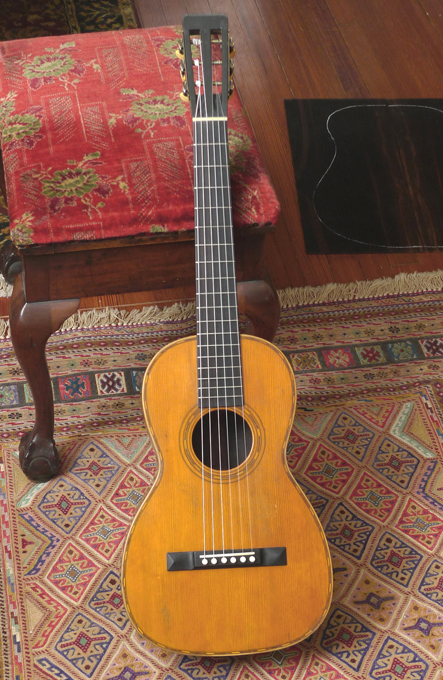 A rare, wonderfully-preserved, 1854 Schmidt & Maul. It’s signed and dated inside: Louis Schmidt Tompkinsville Staten Island New York 388 Broadway August 18th 1854 U. S.
A rare, wonderfully-preserved, 1854 Schmidt & Maul. It’s signed and dated inside: Louis Schmidt Tompkinsville Staten Island New York 388 Broadway August 18th 1854 U. S.- Adirondack top
- Ebonized “ice cream cone” style neck
- solid brazilian rosewood back and sides
- fan braced
- marquetry Purfling around top, with Maple binding
- Maple binding, back
- Width at lower bout: 11 ½ inches
- 100% original finish. No overspray, touch-up, etc. anywhere…wonderful finish
- Not a crack on top, or sides. One small dryness crack on back, near the edge binding on treble side
- Original bridge plate, in great condition
- Reproduction, correct, Ebony bridge
- Bar frets replaced with period correct Bar frets from TJ Thompson
-
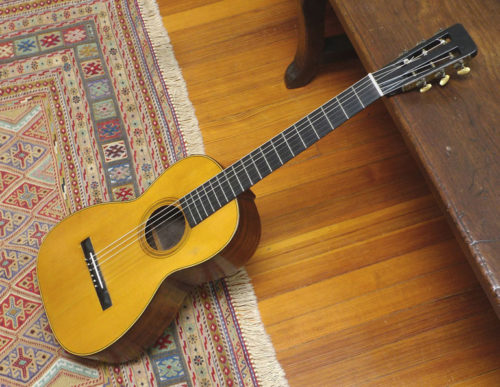 This guitar is the last known guitar in existence, made by Louis Schmidt, the famous contemporary and one-time colleague to the founder of Martin Guitars, the original C.F. Martin. As such, it is a rare example of early American guitar making. And it’s signed by the maker, on the underside of the Adirondack top: Louis Schmidt Wakefield Westchester Cy NY July 9th 1859 U.S. Louis Schmidt worked side by side with CF Martin in the early years. Perhaps the most common misconception about early American guitar history is that C. F. Martin spent his first years in America earning a living as a solitary luthier in his New York workshop. Pay ledgers reveal that as early as 1834 he was paying luthiers to help him make his guitars. Two of these men, Heinrich Schatz and Louis Schmidt, left Martin's employ to make guitars on their own, and each succeeded as top builders. This instrument:
This guitar is the last known guitar in existence, made by Louis Schmidt, the famous contemporary and one-time colleague to the founder of Martin Guitars, the original C.F. Martin. As such, it is a rare example of early American guitar making. And it’s signed by the maker, on the underside of the Adirondack top: Louis Schmidt Wakefield Westchester Cy NY July 9th 1859 U.S. Louis Schmidt worked side by side with CF Martin in the early years. Perhaps the most common misconception about early American guitar history is that C. F. Martin spent his first years in America earning a living as a solitary luthier in his New York workshop. Pay ledgers reveal that as early as 1834 he was paying luthiers to help him make his guitars. Two of these men, Heinrich Schatz and Louis Schmidt, left Martin's employ to make guitars on their own, and each succeeded as top builders. This instrument:- Similar features to circa 1860 Martin 17 style... but different purfling, binding, and slightly different body shape
- All original finish
- Brazilian rosewood back and sides (solid); Adirondack top
- In its original coffin case
- 11 3/8 inches wide at lower bout (a bit larger than a Martin 2 1/2)
- Body: 3 7/8 inches deep
- Original mahogany bridge plate (goes almost all the way across the width of the top, slotted under all the braces)
- Fan bracing pattern
- Plays beautifully. Good bass tone. Action is perfect.
- Ebony Bridge has been off at some point, and reglued on. With a lack of similar guitars on the market, it’s not known if this 19th century bridge on the instrument is the original bridge.
- One repaired crack on top, from bridge to bottom binding; One repaired crack on back. One small crack on top, either top edge of soundhole.
- Original Jerome tuners, reverse gear, working perfectly
- Maple and rosewood purfling/binding on top (no binding on back)
-
Out of stock
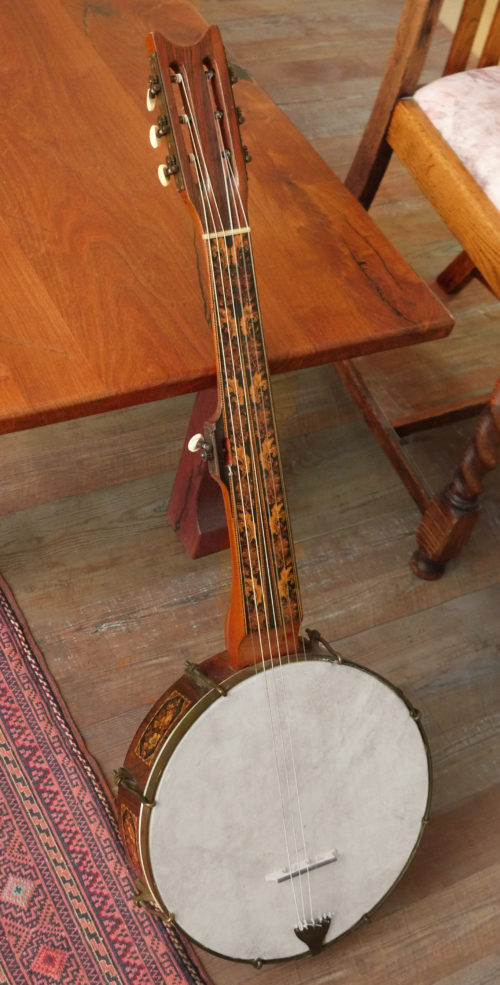 A rare and amazingly original English, Tunbridge ware fretless 7 string banjo. Circa 1850-60. This instrument is 100% original, and even the tailpiece is the original brass tailpiece. This banjo is also rare in that it has original geared tuning machines, not pegs like other examples from the period. The Tunbridge ware banjo is almost impossible to find in this condition and stage of originality. And Tunbridge’s are rare, period. The history? After Joel Sweeney – born to a farming family in Appomattox, Virginia and claimed to have learned to play the banjo from local African population, and the earliest known person to have played the banjo on stage – embarked on a European tour that included stops in London and Edinburgh. He played there for several months, and raised awareness of the instrument in England. As in the U.S., banjos began to be made by local craftsmen – they were still hand made and came in all shapes and sizes, with 5, 6, 7 and even 12 strings, and with one or more drone strings, sometimes on both sides of the neck. Only a few, best ones, such as this instrument, had an amazing amount of work put into them, none more so than those made by a very few firms centered around Tunbridge Wells in Kent, where the local craftsmen specialized in producing a particular form of Treen ware, made from up to 180 different colored woods. Holly, cherry, plum, yew, sycamore, and even imported lignum vitae were all used. The technique was to bind short lengths together and glue them into bundles so when viewed end on, a pattern or picture could be seen. Instrument length: 34 inches. With a 12 inch pot. Eight tensioners and shoes, all original. Original, rare circa 1850 German brass machine tuners (one bent shaft– but still operates perfectly). Original brass tailpiece. Fingerboard, and pot, consisting of inlaid woods as geometric patterns. All the inlays are intact. $2450. In a modern case.
A rare and amazingly original English, Tunbridge ware fretless 7 string banjo. Circa 1850-60. This instrument is 100% original, and even the tailpiece is the original brass tailpiece. This banjo is also rare in that it has original geared tuning machines, not pegs like other examples from the period. The Tunbridge ware banjo is almost impossible to find in this condition and stage of originality. And Tunbridge’s are rare, period. The history? After Joel Sweeney – born to a farming family in Appomattox, Virginia and claimed to have learned to play the banjo from local African population, and the earliest known person to have played the banjo on stage – embarked on a European tour that included stops in London and Edinburgh. He played there for several months, and raised awareness of the instrument in England. As in the U.S., banjos began to be made by local craftsmen – they were still hand made and came in all shapes and sizes, with 5, 6, 7 and even 12 strings, and with one or more drone strings, sometimes on both sides of the neck. Only a few, best ones, such as this instrument, had an amazing amount of work put into them, none more so than those made by a very few firms centered around Tunbridge Wells in Kent, where the local craftsmen specialized in producing a particular form of Treen ware, made from up to 180 different colored woods. Holly, cherry, plum, yew, sycamore, and even imported lignum vitae were all used. The technique was to bind short lengths together and glue them into bundles so when viewed end on, a pattern or picture could be seen. Instrument length: 34 inches. With a 12 inch pot. Eight tensioners and shoes, all original. Original, rare circa 1850 German brass machine tuners (one bent shaft– but still operates perfectly). Original brass tailpiece. Fingerboard, and pot, consisting of inlaid woods as geometric patterns. All the inlays are intact. $2450. In a modern case. -
Out of stock
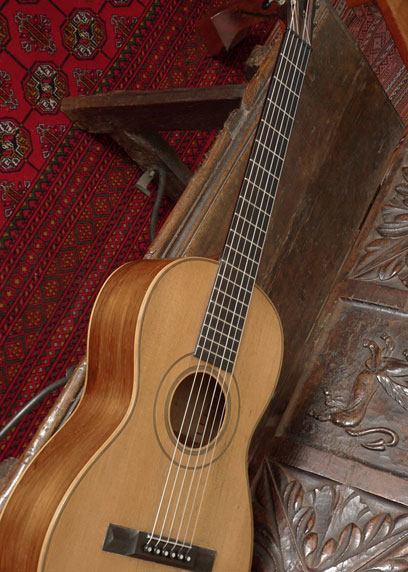 Circa 1860 guitar, style 3 built by well known luthier James Ashborn of Wolcottville, CT, for William Hall & Son music store. Brazilian rosewood back and sides; Adirondack top; maple binding. Rare Brazilian rosewood veneered neck. 100% original, including all original finish, and down to original nut, original bridge (and saddle) that has never been off the guitar. From an article in Vintage Guitar magazine: "Ashborn's design for the guitar was quite innovative for the early 19th century. Instead of making guitars fashioned after the typical parlor-style guitars, he made them in the Spanish style, by taking interior bracing cues from the Spanish while retaining the body of the English guitars. This included a fan brace pattern rather than the more common ladder pattern Ashborn guitars have a very complex dovetail V joint for attaching the head to the neck. The headstock was cut in roughly five steps, using some kind of tracing router, as suggested by the chatter marks on the inside ears of the pegbox. In addition to the complex head design, Ashborn made his own tuning machines in-house. They're made of brass, very much like contemporary machines, with worm gears, cog gears, and rollers. … Ashborn's shop was extremely advanced for its time, having a great deal of know-how and technology. Ashborn understood the need to have the technology as well as the skill, but more importantly he discovered a new way of making high-quality instruments that were affordable. He was able to create a factory environment where workers did what they were good at and, with practice, became very fast and consistent. With a new level of consistency in mass production, he created the path followed by other companies such as Martin, Gibson, and Taylor. Using designs ahead of his time, he was able to bring the sound and change to people who otherwise never would have been able to acquire an instrument of this quality."
Circa 1860 guitar, style 3 built by well known luthier James Ashborn of Wolcottville, CT, for William Hall & Son music store. Brazilian rosewood back and sides; Adirondack top; maple binding. Rare Brazilian rosewood veneered neck. 100% original, including all original finish, and down to original nut, original bridge (and saddle) that has never been off the guitar. From an article in Vintage Guitar magazine: "Ashborn's design for the guitar was quite innovative for the early 19th century. Instead of making guitars fashioned after the typical parlor-style guitars, he made them in the Spanish style, by taking interior bracing cues from the Spanish while retaining the body of the English guitars. This included a fan brace pattern rather than the more common ladder pattern Ashborn guitars have a very complex dovetail V joint for attaching the head to the neck. The headstock was cut in roughly five steps, using some kind of tracing router, as suggested by the chatter marks on the inside ears of the pegbox. In addition to the complex head design, Ashborn made his own tuning machines in-house. They're made of brass, very much like contemporary machines, with worm gears, cog gears, and rollers. … Ashborn's shop was extremely advanced for its time, having a great deal of know-how and technology. Ashborn understood the need to have the technology as well as the skill, but more importantly he discovered a new way of making high-quality instruments that were affordable. He was able to create a factory environment where workers did what they were good at and, with practice, became very fast and consistent. With a new level of consistency in mass production, he created the path followed by other companies such as Martin, Gibson, and Taylor. Using designs ahead of his time, he was able to bring the sound and change to people who otherwise never would have been able to acquire an instrument of this quality." -
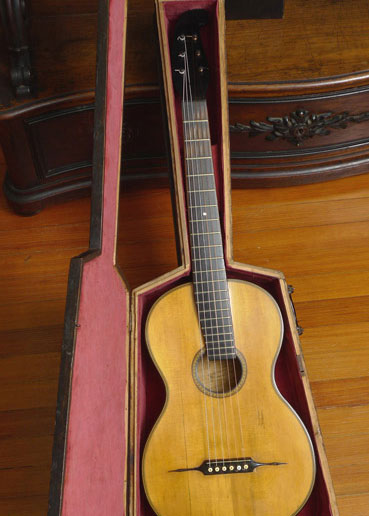 Read the full description below. If you're interested in this guitar, please call 512.922.8596 or contact us here.
Read the full description below. If you're interested in this guitar, please call 512.922.8596 or contact us here. -
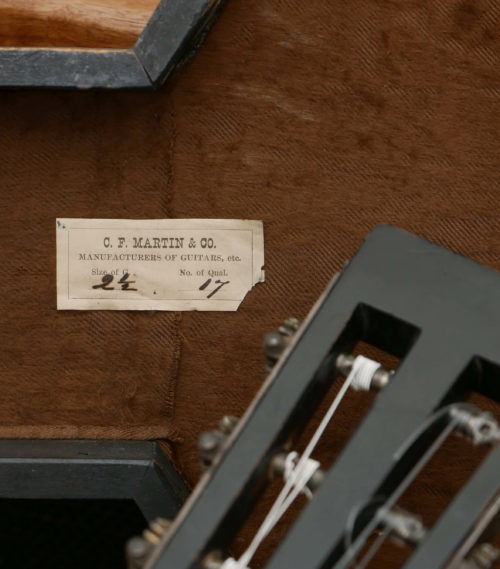 19th century Martin parlor guitar. This lovely sounding Martin 2 1/2-17 features solid Brazilian Rosewood back and sides, Adirondack spruce top, and original Jerome tuners. This particular instrument has a beautiful, lyrical voice. It was made probably circa 1867-1870. There are several clues to establish that: the original coffin case with the guitar has attributes of an earlier case: the small brass handle, and the label inside the case has font and other attributes of late a 1860s case. Also, the particular style of the original Jerome Tuners. Kerfing inside is also indicative of an 1860’s Martin. And, the best clue of all: the 1 ¾ inch nut width. Of course, it’s post-1867, because of the “CF Martin & Co” stamps inside. The top is fan braced, typical of this style. Measurements are: body length 17 7/8", lower bout width 11 5/8", overall length 36 1/2"; scale length 24 ½ inches. 4 inch body depth at end pin; 3 3/8 inch boy depth at neck joint. 1 ¾ inch nut width– may have been a custom order, or just a slightly narrower nut width (from the 1 7/8 more common later) from the factory. 12 fret cedar neck/ebonized, with ice cream cone heel. All original finish, everywhere. A fair-to-low amount of playwear (see photos). Original bar frets in fine condition. Several small hairline cracks in back, repaired. Top and sides also have a couple or repaired cracks. Reproduction ebony bridge– just made by Dick Dubois.. Original bar frets. Original bracing. "C.F. MARTIN &CO/ NEW YORK" hot stamped on back strip inside, and heel block. CF Martin New York stamped on back, by heel joint. Original Jerome tuners, with original buttons– note, one of the sun gears (on the G string tuner) has been replaced, with a different 19th century Martin sun gear (see photo). Historical interest aside (these just-post-civil war Martin guitars are more rare than the 1870’s/1880’s/1890’s examples), this guitar plays wonderfully. It projects glassy brazilian trebles, and clear mids and bass notes. It’s just a joy to play, and it just floats in your hands (due to its very light weight). Action is good, and it plays in tune even on the higher frets. (Note: 19th century Martins can be fitted with: gut strings, classical guitar strings, or sometimes silk and steel/tuned down–depending on the guitar. It’s really a case-by-case basis. One size does not fit all. And different 19th century Martins sound better with different strings. In this case, with this particular guitar, our favorite strings if you want a “classical” style string but more brightness and volume than nylon classical strings: Savarez Alliance composite High Tension strings (note, “high tension” by classical standards– fine for this instrument). This instruments sounds wonderful with those strings. In is original coffin case (and case has all the original hardware, as well as its original cloth interior lining).
19th century Martin parlor guitar. This lovely sounding Martin 2 1/2-17 features solid Brazilian Rosewood back and sides, Adirondack spruce top, and original Jerome tuners. This particular instrument has a beautiful, lyrical voice. It was made probably circa 1867-1870. There are several clues to establish that: the original coffin case with the guitar has attributes of an earlier case: the small brass handle, and the label inside the case has font and other attributes of late a 1860s case. Also, the particular style of the original Jerome Tuners. Kerfing inside is also indicative of an 1860’s Martin. And, the best clue of all: the 1 ¾ inch nut width. Of course, it’s post-1867, because of the “CF Martin & Co” stamps inside. The top is fan braced, typical of this style. Measurements are: body length 17 7/8", lower bout width 11 5/8", overall length 36 1/2"; scale length 24 ½ inches. 4 inch body depth at end pin; 3 3/8 inch boy depth at neck joint. 1 ¾ inch nut width– may have been a custom order, or just a slightly narrower nut width (from the 1 7/8 more common later) from the factory. 12 fret cedar neck/ebonized, with ice cream cone heel. All original finish, everywhere. A fair-to-low amount of playwear (see photos). Original bar frets in fine condition. Several small hairline cracks in back, repaired. Top and sides also have a couple or repaired cracks. Reproduction ebony bridge– just made by Dick Dubois.. Original bar frets. Original bracing. "C.F. MARTIN &CO/ NEW YORK" hot stamped on back strip inside, and heel block. CF Martin New York stamped on back, by heel joint. Original Jerome tuners, with original buttons– note, one of the sun gears (on the G string tuner) has been replaced, with a different 19th century Martin sun gear (see photo). Historical interest aside (these just-post-civil war Martin guitars are more rare than the 1870’s/1880’s/1890’s examples), this guitar plays wonderfully. It projects glassy brazilian trebles, and clear mids and bass notes. It’s just a joy to play, and it just floats in your hands (due to its very light weight). Action is good, and it plays in tune even on the higher frets. (Note: 19th century Martins can be fitted with: gut strings, classical guitar strings, or sometimes silk and steel/tuned down–depending on the guitar. It’s really a case-by-case basis. One size does not fit all. And different 19th century Martins sound better with different strings. In this case, with this particular guitar, our favorite strings if you want a “classical” style string but more brightness and volume than nylon classical strings: Savarez Alliance composite High Tension strings (note, “high tension” by classical standards– fine for this instrument). This instruments sounds wonderful with those strings. In is original coffin case (and case has all the original hardware, as well as its original cloth interior lining). -
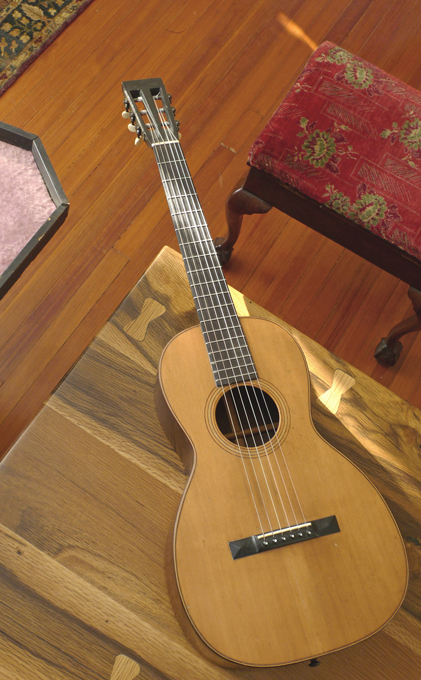 Another all-original pre-war Martin… but you have to go back a few more wars on this one- to just after the Civil War. This guitar even has its original coffin case–necessary in the days when Martin guitars were shipped out by railroad or wagon train. The figured Brazilian rosewood back and sides are unusual– in these decades of the 19th century (and through the middle of the 20th) Martin usually did not use this kind of figured, lovely Brazilian (they preferred the more straight-grained variety). On this guitar, for the sake of originality, we’ve kept its original saddle intact. The original ivory saddle is worn through at the strings, but still functions nicely.
Another all-original pre-war Martin… but you have to go back a few more wars on this one- to just after the Civil War. This guitar even has its original coffin case–necessary in the days when Martin guitars were shipped out by railroad or wagon train. The figured Brazilian rosewood back and sides are unusual– in these decades of the 19th century (and through the middle of the 20th) Martin usually did not use this kind of figured, lovely Brazilian (they preferred the more straight-grained variety). On this guitar, for the sake of originality, we’ve kept its original saddle intact. The original ivory saddle is worn through at the strings, but still functions nicely.- Fan braced
- Adirondack top
- Ebonized “ice cream cone” style neck
- Solid Brazilian rosewood back and sides
- 100% original finish…. No overspray, touch-up, etc. anywhere…wonderful finish
- Original ebony bridge, and bridge plate
- Two cracks in spruce top; one is bridge to bottom of top; the other is from near bridge to soundhole; first one described is beneath an internal brace; second is 2mm adjacent to a different brace. Neither need attention and are left alone to preserve originality.
- Characteristic, three Martin stamps: “CF Martin & Co, New York” ink stamped on neck block; “CF Martin & Co, New York” ink stamped on center strip inside; and “CF Martin New York”, stamped/pressed into brazilian rosewood back of guitar, up near the heel. (note: this guitar is not signed personally by factory foreman, etc, on underside of top…. This fact, and the other details, points to a circa 1870 date, not 1880s or 90’s).
-
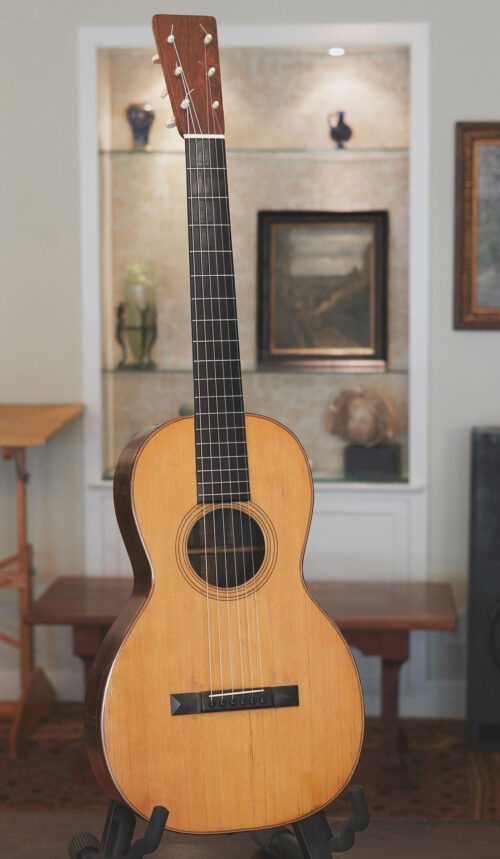
In this period (any Martin guitar made before 1898) there were of course no serial numbers on Martins, and no one signed the instruments inside with a date as they often did in the later 1880’s. But it has all the hallmarks of 1870s to mid-1880’s – and most likely earlier in that period, about 1870, judging by the endstrip material.
It has the original friction tuners – with the exception of the Low E string tuner that was missing and so has been replaced (probably a hundred years ago) with a tuning peg to match the originals.
The size 2 is a great size, it’s a larger guitar than the more common size 2 ½ from this era.
Amazing tone from this guitar. See and hear this guitar being played:
All careful work has been done on this guitar, and it won’t need anything else – it’s a great guitar for the player who wants the best Martin tone and playability – a tonal gem from the 19th century Martin factory in Nazareth.
• Spruce top over Brazilian Rosewood back and sides.
• Spanish heel (not the ice cream cone heel of the less expensive Martins)
• Peg head, with original tuners (with one replacement– the high E string peg)
• Light overspray on top done ages ago, so it’s not very noticeable.
A bit more overspray on back and sides, done decades and decades ago.
• Fan braced – as are most of the best sounding Martins from this era.
• Original thin maple bridge plate
• Original ebony fretboard; Original bar frets with some wear but they’re still pretty high.
• Soft V neck
• Scale length: 24.5 inches
• Width at lower bout: 12 inches
• Nut width: 1 13/16 inch
Multiple cracks on top, all repaired (see photos); multiple cracks on back, all repaired.
Heel has a tiny crack – but it looks like there was never any separation, more of surface crack (see photos)
Two areas by top edge of bridge, either end, where wood was splintered a bit, now repaired and stable. (See photos)
This guitar has seen multiple crack repairs, but it’s structurally sound now, and needs no work going forward. It’s priced low to reflect the work done. It has marvelous sound and projection, and plays with great low action and great intonation all up and down the fretboard. Strung with Savarez Alliance strings.
It would be a great addition to a player wanting a superb example of the best Martin sound from the 19th century – at an affordable cost that’s impossible to find in today’s market.
Ships in a modern hard shell case.
Price: $4,850. – plus shipping
-
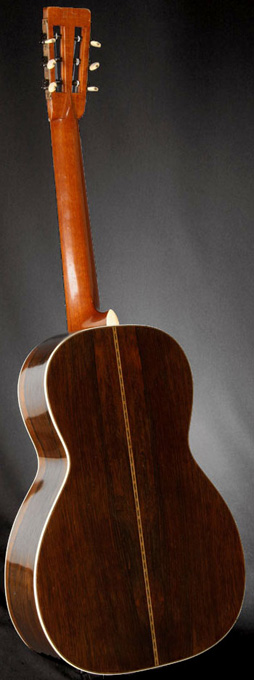 Signed by Martin factory foreman, underside of top: “6/1886”, this 0-28 is in stunning original condition. 1886 is the last year of the original factory in Nazareth, before Martin built the new factory addition in 1887. It is also the last year before they installed mechanized steam-run equipment to bend sides. So this wonderful 0-28, is one of the last of the totally hand-crafted Martins, built without mechanized equipment, and signed as such, 1886. Instrument is 100% original: finish, bridge, ivory nut, ivory saddle, ivory pins, bar frets, everything.
Signed by Martin factory foreman, underside of top: “6/1886”, this 0-28 is in stunning original condition. 1886 is the last year of the original factory in Nazareth, before Martin built the new factory addition in 1887. It is also the last year before they installed mechanized steam-run equipment to bend sides. So this wonderful 0-28, is one of the last of the totally hand-crafted Martins, built without mechanized equipment, and signed as such, 1886. Instrument is 100% original: finish, bridge, ivory nut, ivory saddle, ivory pins, bar frets, everything.- Crack-free
- repaired center seam on top
- Shows very little wear
- Scalloped braces (X-braced)
- original maple bridge plate
- original French-polish shellac finish throughout
- 13.5" wide at lower bout, and 4.25" deep at the endpin
- 24.9" scale length
- 1-7/8" wide nut
- soft-V neck profile.
-
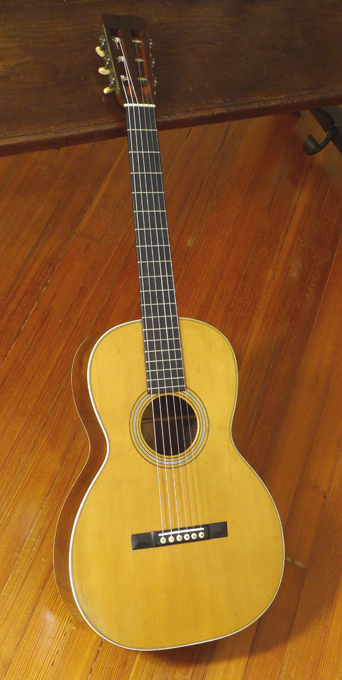 Signed by Martin factory foreman, underside of top: “Dec. 8, 1893”, this 0-28 is in wonderful original condition.
Signed by Martin factory foreman, underside of top: “Dec. 8, 1893”, this 0-28 is in wonderful original condition.- Instrument is 100% original: finish, bridge, ivory nut, ivory saddle, ivory bridge pins, bar frets
- Brazilian Rosewood Back and Sides
- Adirondack Spruce top
- Shows very little wear
- Scalloped braces (X-braced)
- Original maple bridge plate in perfect condition
- Original French-polish shellac finish throughout
- 13.5" wide at lower bout, and 4.25" deep at the endpin
- 24.9" scale length
- 1-7/8" wide nut
- Soft-V neck profile
- A couple small top cracks, professionally repaired and not an issue. Two finish checks/cracks, that due not go through wood, on back
-
 This extraordinary guitar, completed by C.T. Beitel in June of 1894, is signed and dated by him on the underside of the top. The guitar is in remarkably original condition. And it plays wonderfully. C.T. Beitel (Clemence T. Beitel, 1869-1916) was closely associated with C.F. Martin & Co. in the 1890’s. The Beitels are well known to have been closely associated with the Martin family in these years, both personally (including through marriage) and in the Martin guitar business. According to some correspondence and background research from family members obtained with this guitar, C.T. Beitel was the first American-born person to serve an apprenticeship at Martin Guitars. C.T. Beitel was a cousin to C.A. Zoebisch– who was of course the famous Martin guitar distributor and sometimes-partner of C.F. Martin & Co. in this period. Although this guitar is strikingly faithful to Martin specs, this is most likely one of C.T. Beitel’s guitars made by him to market separately from Martin. It is documented that at least one of the Beitel family had an ongoing guitar making and marketing business in the late 1890’s. Is this Beitel guitar one of the first made under the “Beitel” name? Certainly. Are there others remaining today? There are none known of by us–making this a rare and highly collectible guitar. Similar to a Martin 2-27… but not exactly. More like a cross between a 2-27, a “28” style–because of the wonderful Herringbone purfling/binding on the top– and a 30’s or higher style with its very fancy Jerome tuners.
This extraordinary guitar, completed by C.T. Beitel in June of 1894, is signed and dated by him on the underside of the top. The guitar is in remarkably original condition. And it plays wonderfully. C.T. Beitel (Clemence T. Beitel, 1869-1916) was closely associated with C.F. Martin & Co. in the 1890’s. The Beitels are well known to have been closely associated with the Martin family in these years, both personally (including through marriage) and in the Martin guitar business. According to some correspondence and background research from family members obtained with this guitar, C.T. Beitel was the first American-born person to serve an apprenticeship at Martin Guitars. C.T. Beitel was a cousin to C.A. Zoebisch– who was of course the famous Martin guitar distributor and sometimes-partner of C.F. Martin & Co. in this period. Although this guitar is strikingly faithful to Martin specs, this is most likely one of C.T. Beitel’s guitars made by him to market separately from Martin. It is documented that at least one of the Beitel family had an ongoing guitar making and marketing business in the late 1890’s. Is this Beitel guitar one of the first made under the “Beitel” name? Certainly. Are there others remaining today? There are none known of by us–making this a rare and highly collectible guitar. Similar to a Martin 2-27… but not exactly. More like a cross between a 2-27, a “28” style–because of the wonderful Herringbone purfling/binding on the top– and a 30’s or higher style with its very fancy Jerome tuners.- No “Martin” stamps anywhere
- “C.T. Beitel” paper label on neck block (Martin stamp beneath the label? Uncertain)
- Signed and dated on underside of top: “C.T. Beitel, 6/94, Easton” (i.e. Easton, PA)
- X-braced top
- All original finish; no touch-ups etc
- Pearl inlay around sound hole
- Herringbone purfling around top
- Real Ivory binding, top, and back
- Bound Ivory neck
- Ebony bridge
- Ebony fretboard (bound in Ivory)
- Original Maple bridge plate
- Size: a just bit bigger at lower bout than a Martin “2” size: 12 1/4 inches
- Scale length: 24 3/4 inches
- Body length: 18 3/8 inches
- String spacing at bridge: 2 3/8 inches - Nut width: 1 7/8 inches
- Body depth at bottom of guitar: 4 inches
- Top: Adirondack Spruce
- Back and sides: solid Brazilian Rosewood
- Neck: Cedar
- Headstock: Brazilian Rosewood veneer
- Tuners: original, German-made Jerome tuners, with fancy flower engraving, and oval shaped Ivory tuner buttons. These tuners are typically found only on the highest model Martin guitars of those years
- Tuner buttons: Ivory, oval-shaped
-
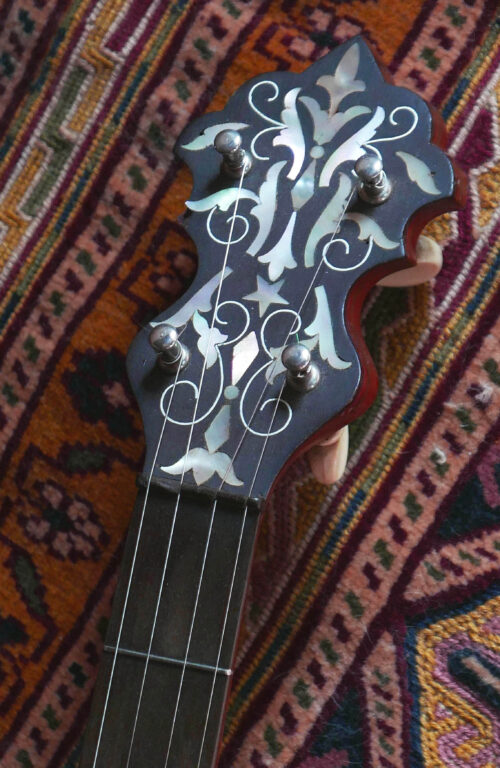 A rare, circa 1895 S.S. Stewart “Special Thoroughbred” 5-string banjo, in original condition. Silver plated pot 5-string neck is cherry Ebony fingerboard Carved heel Mother of pearl headstock inlays, with silver wire inserts also Tone ring is nickel plated on a birds-eye maple pot All of the special logos etc, are still on the inside of the banjo. Condition: amazing, original condition. Does have some wear, but it’s still shiny, and in great condition. (It even has its original leather case, not a very practical case, but original.) Tone is very nice, more focused and loud than the typical turn of the century open-back banjo. Price: $2950.
A rare, circa 1895 S.S. Stewart “Special Thoroughbred” 5-string banjo, in original condition. Silver plated pot 5-string neck is cherry Ebony fingerboard Carved heel Mother of pearl headstock inlays, with silver wire inserts also Tone ring is nickel plated on a birds-eye maple pot All of the special logos etc, are still on the inside of the banjo. Condition: amazing, original condition. Does have some wear, but it’s still shiny, and in great condition. (It even has its original leather case, not a very practical case, but original.) Tone is very nice, more focused and loud than the typical turn of the century open-back banjo. Price: $2950. -
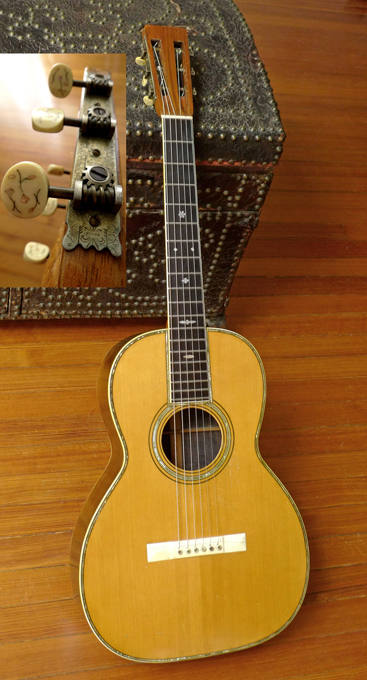 Exquisite, and a joy to play (… the top level, largest guitar that Martin made at the turn of the 20th century– with tone that shows off what Frank Henry Martin was proud of when he personally signed the inside of this instrument in April, 1903…)
Exquisite, and a joy to play (… the top level, largest guitar that Martin made at the turn of the 20th century– with tone that shows off what Frank Henry Martin was proud of when he personally signed the inside of this instrument in April, 1903…) -
 This fine Brazilian Rosewood 12-fret Martin is a joy to play, and it’s properly set up for steel strings. The grandson of C. F. Martin, Sr., Frank Henry Martin oversaw the Martin business from 1880 until well into twentieth century, and was responsible for the creation of the Style 0. I’m sure he loved this guitar–he personally signed the instrument, in cursive, under the top: “# 10082 Oct. 17th, 1905 F.H.M.” This 0-21 combines the exquisite tone of a 100 year old Martin, with some wonderful restoration. Guitar was refinished, probably decades ago, and it is a beautiful, French polish finish that has all the earmarks of an original finish. You can see the pores and saw marks in the Brazilian rosewood. No heavy-handed finish here, it’s a natural finish that lets the grain and color of the wood come through. And the tone, too, that sweet tone you can only get from Brazilian this old. The ebony pyramid bridge is a replacement, and features a compensated saddle, so intonation is dead on. (The bridge plate is the original small maple plate, in perfect condition.) Original tuners. Crack-free top and sides. There is only one very small crack, on the back, about 3 inches long, professionally repaired. The neck was set recently by Tony Nobles, and the original bar frets dressed. It plays, and sounds, like a late 20’s 12-fret Brazilian rosewood Martin.
This fine Brazilian Rosewood 12-fret Martin is a joy to play, and it’s properly set up for steel strings. The grandson of C. F. Martin, Sr., Frank Henry Martin oversaw the Martin business from 1880 until well into twentieth century, and was responsible for the creation of the Style 0. I’m sure he loved this guitar–he personally signed the instrument, in cursive, under the top: “# 10082 Oct. 17th, 1905 F.H.M.” This 0-21 combines the exquisite tone of a 100 year old Martin, with some wonderful restoration. Guitar was refinished, probably decades ago, and it is a beautiful, French polish finish that has all the earmarks of an original finish. You can see the pores and saw marks in the Brazilian rosewood. No heavy-handed finish here, it’s a natural finish that lets the grain and color of the wood come through. And the tone, too, that sweet tone you can only get from Brazilian this old. The ebony pyramid bridge is a replacement, and features a compensated saddle, so intonation is dead on. (The bridge plate is the original small maple plate, in perfect condition.) Original tuners. Crack-free top and sides. There is only one very small crack, on the back, about 3 inches long, professionally repaired. The neck was set recently by Tony Nobles, and the original bar frets dressed. It plays, and sounds, like a late 20’s 12-fret Brazilian rosewood Martin. -
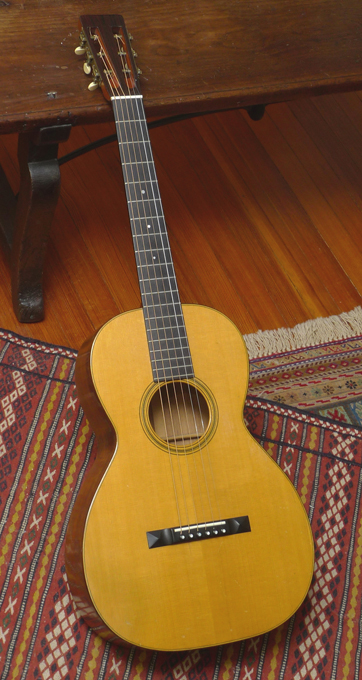 The grandson of Martin Guitar founder C. F. Martin, Sr., Frank Henry Martin suddenly found himself in control of the family business at the age of 22 when his father died in 1888 and left him unexpectedly in charge. The guitar market was still immature, and the young country was headed into an economic panic in the 1890's, but the young Frank Henry Martin quickly turned a traditional German business close to bankruptcy into a major force in the world of American music. Along with the young Frank Martin’s now legendary work ethic and marketing acumen, he is credited with personally revamping the Martin model line-up at the turn of the new century. Eschewing the trappings of an executive, he literally worked along side the shop craftsmen, day in and day out, six days a week. And he made the Style 18 the mainstay of the Martin catalog. This instrument is a living testament to that legacy– he personally signed this instrument, in cursive, under the top, on the fourth of February, 1907: “ 10381 2/4/07 F.H.M. ” Martin was still using Brazilian Rosewood for the back and sides for their 0-18 model in this 1907, and the tone of this instrument reflects all that is great about the combination of Brazilian back and sides, and Adirondack spruce (top), with a cedar neck, on the perennially great Size 0 Martin 12-fret, in all its Brazilian rosewood permutations through two centuries. This guitar is in remarkably original condition, and is completely crack-free. Just a few minor dings and superficial scratches. The finish is 100% original, with no touch-ups of any kind. The bar frets were replaced by us with period-correct bar frets–with material obtained from T.J. Thomson. (Several frets were missing, so we decided to replace all the frets.) Original ivory saddle, and bridge pins. Bridge has never been off the guitar. At some time in the past a neck set was done, so action is great, and the neck is straight. Original ebony nut is in the case. An ivory nut is installed on the guitar to accommodate silk & steel strings–which it does wonderfully. An Adirondack/Brazilian 12-fret 0-sized Martin over a century old yet in this kind of original condition, is very rare.
The grandson of Martin Guitar founder C. F. Martin, Sr., Frank Henry Martin suddenly found himself in control of the family business at the age of 22 when his father died in 1888 and left him unexpectedly in charge. The guitar market was still immature, and the young country was headed into an economic panic in the 1890's, but the young Frank Henry Martin quickly turned a traditional German business close to bankruptcy into a major force in the world of American music. Along with the young Frank Martin’s now legendary work ethic and marketing acumen, he is credited with personally revamping the Martin model line-up at the turn of the new century. Eschewing the trappings of an executive, he literally worked along side the shop craftsmen, day in and day out, six days a week. And he made the Style 18 the mainstay of the Martin catalog. This instrument is a living testament to that legacy– he personally signed this instrument, in cursive, under the top, on the fourth of February, 1907: “ 10381 2/4/07 F.H.M. ” Martin was still using Brazilian Rosewood for the back and sides for their 0-18 model in this 1907, and the tone of this instrument reflects all that is great about the combination of Brazilian back and sides, and Adirondack spruce (top), with a cedar neck, on the perennially great Size 0 Martin 12-fret, in all its Brazilian rosewood permutations through two centuries. This guitar is in remarkably original condition, and is completely crack-free. Just a few minor dings and superficial scratches. The finish is 100% original, with no touch-ups of any kind. The bar frets were replaced by us with period-correct bar frets–with material obtained from T.J. Thomson. (Several frets were missing, so we decided to replace all the frets.) Original ivory saddle, and bridge pins. Bridge has never been off the guitar. At some time in the past a neck set was done, so action is great, and the neck is straight. Original ebony nut is in the case. An ivory nut is installed on the guitar to accommodate silk & steel strings–which it does wonderfully. An Adirondack/Brazilian 12-fret 0-sized Martin over a century old yet in this kind of original condition, is very rare. -
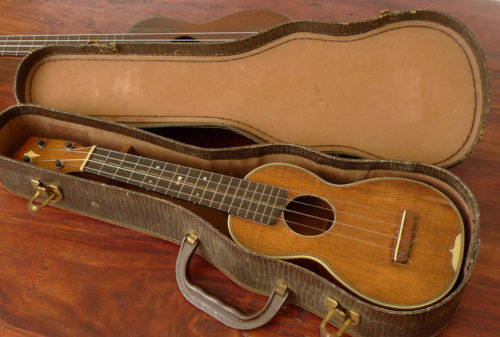 One of the first Martin 3K Ukeleles ever made. This is possibly a prototype, one of the first, all hand-made Martin 3K Ukeleles, made probably before the official introduction of the model by Martin in 1919-1920. It has many signs that it was the one of the first ones:
One of the first Martin 3K Ukeleles ever made. This is possibly a prototype, one of the first, all hand-made Martin 3K Ukeleles, made probably before the official introduction of the model by Martin in 1919-1920. It has many signs that it was the one of the first ones:- Ebony fretboard is hand-cut
- Fretboard inlays are hand-cut
- There is an "A" on the back of headstock... could be a marking by the Martin craftsmen in-house to indicate a prototype.
- Several cracks on back (repaired)
- Two cracks on top (repaired)
- There is one missing brace, a back brace, inside. Since ukeleles are so small, that brace has no real structural importance, so we decided not to replace it
- The sound hole was at some point enlarged slightly, either at the factory, or later. Probably later– so we’ll call it the Tony Rice model… this modification does add loudness
- The finish is all original.
- Original striped nut
- 3 lines inlaid down center of fingerboard.
- 7 ply side binding
- Celluloid ornament on top, behind bridge (known as the "parend").
- Small pearl paired-diamond inlays at fret 5, 7, 9– hand-cut. With the “bowtie” at the 7th fret
- Kite-shaped celluloid ornament on front of headstock
- Original friction pegs
- Ebony fretboard
- C.F. Martin & Co. stamp on back of headstock.
-
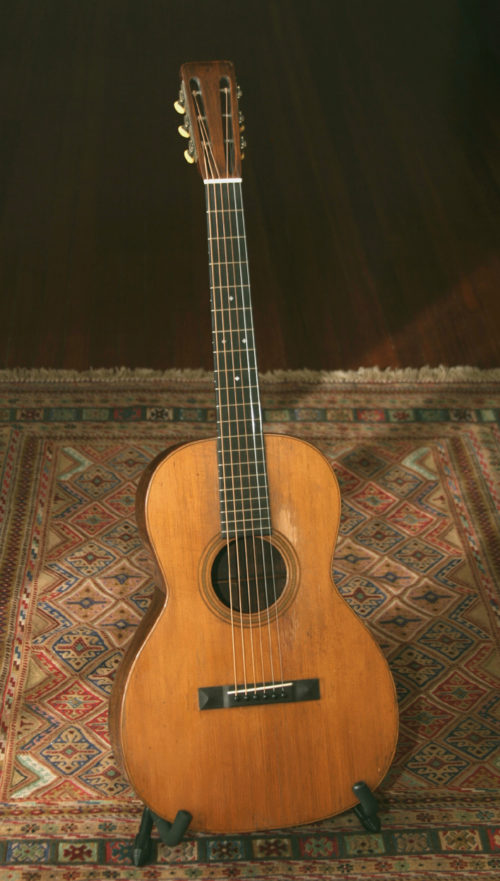 This big 12-fret Brazilian Rosewood pre-war Martin is properly set up for steel strings, with new replacement ebony pyramid bridge meticulously made to original specs, but compensated for steel string, perfect intonation. All braces original and in great shape. Original bridge plate. All original finish everywhere. This guitar has all the tone you'd expect from a pre-war 00 Brazilian Martin. It's had restoration work, all by us, recently, as follows. Hide glue used in all repairs/restoration.
This big 12-fret Brazilian Rosewood pre-war Martin is properly set up for steel strings, with new replacement ebony pyramid bridge meticulously made to original specs, but compensated for steel string, perfect intonation. All braces original and in great shape. Original bridge plate. All original finish everywhere. This guitar has all the tone you'd expect from a pre-war 00 Brazilian Martin. It's had restoration work, all by us, recently, as follows. Hide glue used in all repairs/restoration.- Several cracks in sides, back, and top professionally repaired (5 or 6 cracks overall)
- Small hole drilled in top of headstock many decades ago (to hang the guitar on a wall presumably) has been expertly filled and finished with a piece of Brazilian rosewood veneer, on front, to match the veneer of the headstock.
- Neck set.
- New replacement ebony pyramid bridge meticulously made to original specs, but compensated to steel string intonation. Scratch marks in spruce top, on either side of bridge, filled and finished.
- All new, replacement Bar Frets
- To the thin maple, original bridge plate, we carefully added tiny maple ring/plugs, with hide glue, into the holes, to address bridge pins holes slightly enlarged over the years.
- Older repaired small crack in heel expertly touched up. It's 100% stable. (It appears to be a surface/finish crack.) It's very hard to see even up close, and impossible to photograph.
-
Out of stock
 The Larson Brothers of Chicago never marketed any guitar, throughout their long career, that was marked “Larson”. Their designs were branded by Maurer, Stahl, Prairie State, Stetson, and a few other guitar makers– but never “Larson”. They were also known for making many “off-catalog” guitars, i.e. guitars with combinations of features that varied from the Maurer, Stahl, etc, catalogs, and guitars that were not marked at all with a brand. This guitar is a Larson Bros creation that is not marked at all. It is a custom made instrument–but it has all the typical Larson hallmarks. The tone of this Larson is every bit as wonderful as the Maurer/Larson listed above, indeed it is quite similar, due to the same patented “built under tension” design, and X-bracing. This Larson does not have laminated braces (it’s well documented that laminated braces were only used on certain models–and their use was not related to level or price.) Every part of this guitar is original, including original finish. There are two repaired cracks on the back, and three small, repaired cracks on top.
The Larson Brothers of Chicago never marketed any guitar, throughout their long career, that was marked “Larson”. Their designs were branded by Maurer, Stahl, Prairie State, Stetson, and a few other guitar makers– but never “Larson”. They were also known for making many “off-catalog” guitars, i.e. guitars with combinations of features that varied from the Maurer, Stahl, etc, catalogs, and guitars that were not marked at all with a brand. This guitar is a Larson Bros creation that is not marked at all. It is a custom made instrument–but it has all the typical Larson hallmarks. The tone of this Larson is every bit as wonderful as the Maurer/Larson listed above, indeed it is quite similar, due to the same patented “built under tension” design, and X-bracing. This Larson does not have laminated braces (it’s well documented that laminated braces were only used on certain models–and their use was not related to level or price.) Every part of this guitar is original, including original finish. There are two repaired cracks on the back, and three small, repaired cracks on top.- Lower bout width: 12 5/8 inches
- Brazilian rosewood back and sides
- Ivory celluloid Bound fretboard
- Ivory celluloid Bound headstock
- Spruce top
- X braced
- Larson’s patented “built under tension” design
- Rosette: Abalone pearl and wood inlay bordering the sound hole
- Radiused ebony fingerboard, and Classic Larson Brothers’ “ebony below the binding”
- Engraved inlays on fretboard
- Original tuners
- Original ebony bridge
- Original bridge pins
- 1-7/8" wide nut
- 2 1/4" bridge string spacing
- 24.3" scale length
- One-piece mahogany neck, round C shaped neck profile.
-
 The Larson Brothers of Chicago never marketed any guitar, throughout their long career, that was marked “Larson”. Their designs were branded by Maurer, Stahl, Prarie State, Stetson, and a few other guitar makers– but never “Larson”. They were also known for making many “off-catalog” guitars, i.e. guitars with combinations of features that varied from the Maurer, Stahl, etc, catalogs, and guitars that were not marked at all with a brand. This guitar is a Larson Bros creation that is not marked at all. It is a custom made instrument–but it has all the typical Larson hallmarks. The tone of this Larson is every bit as wonderful as the Maurer/Larson listed above, indeed it is quite similar, due to the same patented “built under tension” design, and X-bracing. This Larson does not have laminated braces (it’s well documented that laminated braces were only used on certain models–and their use was not related to level or price.) Every part of this guitar is original, including original finish. There are two repaired cracks on the back, and three small, repaired cracks on top.
The Larson Brothers of Chicago never marketed any guitar, throughout their long career, that was marked “Larson”. Their designs were branded by Maurer, Stahl, Prarie State, Stetson, and a few other guitar makers– but never “Larson”. They were also known for making many “off-catalog” guitars, i.e. guitars with combinations of features that varied from the Maurer, Stahl, etc, catalogs, and guitars that were not marked at all with a brand. This guitar is a Larson Bros creation that is not marked at all. It is a custom made instrument–but it has all the typical Larson hallmarks. The tone of this Larson is every bit as wonderful as the Maurer/Larson listed above, indeed it is quite similar, due to the same patented “built under tension” design, and X-bracing. This Larson does not have laminated braces (it’s well documented that laminated braces were only used on certain models–and their use was not related to level or price.) Every part of this guitar is original, including original finish. There are two repaired cracks on the back, and three small, repaired cracks on top.- Lower bout width: 12 5/8 inches
- Brazilian rosewood back and sides
- Ivory celluloid Bound fretboard
- Ivory celluloid Bound headstock
- Spruce top
- X braced
- Larson’s patented “built under tension” design
- Rosette: Abalone pearl and wood inlay bordering the sound hole
- Radiused ebony fingerboard, and Classic Larson Brothers’ “ebony below the binding”
- Engraved inlays on fretboard
- Original tuners
- Original ebony bridge
- Original bridge pins
- 1-7/8" wide nut
- 2 1/4" bridge string spacing
- 24.3" scale length
- One-piece mahogany neck, round C shaped neck profile.
-
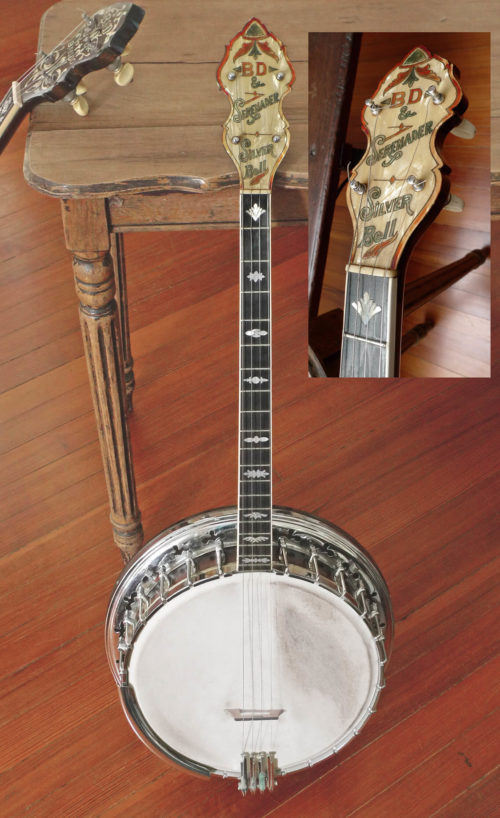 This 1922 Bacon & Day Serenader, tenor banjo is in great original condition. The well-worn head can be easily replaced– we retained it for originality. The banjo shows little wear. And all the parts are original–Tailpiece, tuners, dowel, everything. This is a golden era B&D, not one of the later 30s/40's banjos that are more common. In this condition it is rare. And it comes in its original hard shell case. Price: $1695.
This 1922 Bacon & Day Serenader, tenor banjo is in great original condition. The well-worn head can be easily replaced– we retained it for originality. The banjo shows little wear. And all the parts are original–Tailpiece, tuners, dowel, everything. This is a golden era B&D, not one of the later 30s/40's banjos that are more common. In this condition it is rare. And it comes in its original hard shell case. Price: $1695. -
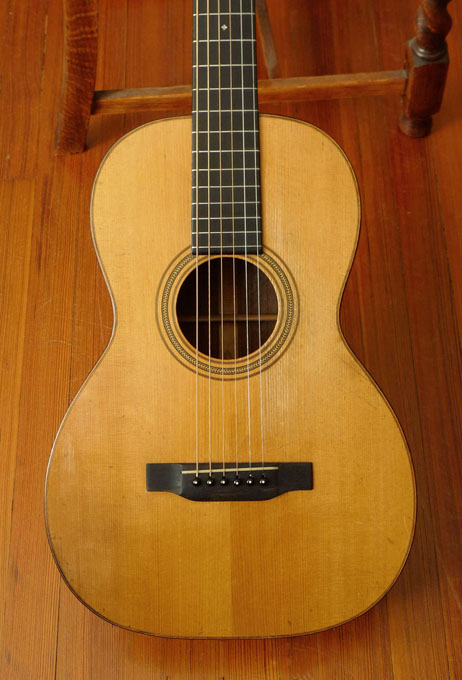 This is a wonderful Martin 0-21, but with “the best of both worlds”: the light build of 1924– combined with 1930’s robust, “braced for steel” construction. It left the factory in 1924, but it went back to Martin in 1934 for a neck set, new belly bridge, and to get set up fully for steel strings. Details below.
This is a wonderful Martin 0-21, but with “the best of both worlds”: the light build of 1924– combined with 1930’s robust, “braced for steel” construction. It left the factory in 1924, but it went back to Martin in 1934 for a neck set, new belly bridge, and to get set up fully for steel strings. Details below.- All original finish
- Original 1934 bridge, and bridge plate from Martin Factory
- Original saddle
- Original “arrowhead” design tuners. The first Waverly tuners showed up in 1924/25 and remained until after the war. The arrowhead design, seen here on the tuner plates, showed up also in 1924, still with the shafts placed underneath the gears / string posts.
- Crack free (there is one cleat inside guitar, on upper bout, back. There is no visible crack that goes through wood to inside, just a tiny finish crack on outside. No doubt the Martin luthier place the cleat there in 1934 as a preventative measure (that worked).
- The combination of the original thin-profile neck, with the braced-for-steel modifications by Martin factory in 1934, make for a very robust guitar– you can play it hard and it holds up and projects like a 30’s Martin.
- Sold by Martin factory and shipped to Rudolph Wurlitzer Co. in Chicago on March 18, 1924. (This guitar does not have “Wulitzer” stamps, rather the normal CF Martin Stamps in all the correct places. This is consistent with Martin/Wurlitzer timetable in “Martin Guitars: A Technical Reference” by Johnston and Boak, 2009, p. 248.)
- June 20, 1933: the owner wrote to Martin that instrument needed a neck set and the bridge was “adrift”. Martin replied on June 23 that the normal guarantee would probably cover this work.
- Owner sent the guitar to Martin on July 3, 1934. Martin reported back to owner on July 16 that readjusting the neck and regluing the bridge would be covered by the warranty, Martin also offered a “new” bridge (meaning belly bridge) for $1.50. Martin also said that some binding could be reglued and repaired for $3.00.
- Work done at Martin, July 1934. The luthier at Martin replaced the bridge with a 1934 spec ebony belly bridge, and replaced the bridge plate with a perfect, tucked, small maple bridge plate. Martin luthier signs underside of spruce top: "7-25-1934”, and put his initials (“W.T.W.”), right by the edge of the X-brace to the top/upper bout. Of course, the back was taken off the guitar to do the above work. But being perfectly done at Martin factory in 1934, there are no visible signs of that– back binding is perfect.
- Total repair bill from Martin factory in 1934: $4.50. Paid by check, and Martin return ships the 0-21 to owner on August 15th, 1934.